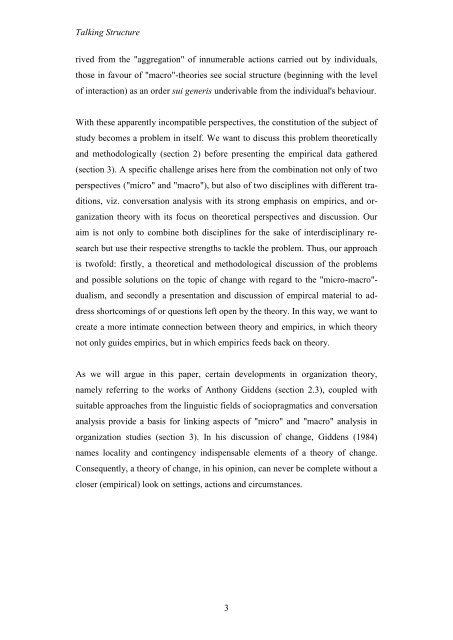In organisation theory, bridging the gap between „micro“ and „macro ...
In organisation theory, bridging the gap between „micro“ and „macro ...
In organisation theory, bridging the gap between „micro“ and „macro ...
Create successful ePaper yourself
Turn your PDF publications into a flip-book with our unique Google optimized e-Paper software.
Talking Structure<br />
rived from <strong>the</strong> "aggregation" of innumerable actions carried out by individuals,<br />
those in favour of "macro"-<strong>the</strong>ories see social structure (beginning with <strong>the</strong> level<br />
of interaction) as an order sui generis underivable from <strong>the</strong> individual's behaviour.<br />
With <strong>the</strong>se apparently incompatible perspectives, <strong>the</strong> constitution of <strong>the</strong> subject of<br />
study becomes a problem in itself. We want to discuss this problem <strong>the</strong>oretically<br />
<strong>and</strong> methodologically (section 2) before presenting <strong>the</strong> empirical data ga<strong>the</strong>red<br />
(section 3). A specific challenge arises here from <strong>the</strong> combination not only of two<br />
perspectives ("micro" <strong>and</strong> "macro"), but also of two disciplines with different tra-<br />
ditions, viz. conversation analysis with its strong emphasis on empirics, <strong>and</strong> or-<br />
ganization <strong><strong>the</strong>ory</strong> with its focus on <strong>the</strong>oretical perspectives <strong>and</strong> discussion. Our<br />
aim is not only to combine both disciplines for <strong>the</strong> sake of interdisciplinary re-<br />
search but use <strong>the</strong>ir respective strengths to tackle <strong>the</strong> problem. Thus, our approach<br />
is twofold: firstly, a <strong>the</strong>oretical <strong>and</strong> methodological discussion of <strong>the</strong> problems<br />
<strong>and</strong> possible solutions on <strong>the</strong> topic of change with regard to <strong>the</strong> "micro-macro"-<br />
dualism, <strong>and</strong> secondly a presentation <strong>and</strong> discussion of empircal material to ad-<br />
dress shortcomings of or questions left open by <strong>the</strong> <strong><strong>the</strong>ory</strong>. <strong>In</strong> this way, we want to<br />
create a more intimate connection <strong>between</strong> <strong><strong>the</strong>ory</strong> <strong>and</strong> empirics, in which <strong><strong>the</strong>ory</strong><br />
not only guides empirics, but in which empirics feeds back on <strong><strong>the</strong>ory</strong>.<br />
As we will argue in this paper, certain developments in organization <strong><strong>the</strong>ory</strong>,<br />
namely referring to <strong>the</strong> works of Anthony Giddens (section 2.3), coupled with<br />
suitable approaches from <strong>the</strong> linguistic fields of sociopragmatics <strong>and</strong> conversation<br />
analysis provide a basis for linking aspects of "micro" <strong>and</strong> "macro" analysis in<br />
organization studies (section 3). <strong>In</strong> his discussion of change, Giddens (1984)<br />
names locality <strong>and</strong> contingency indispensable elements of a <strong><strong>the</strong>ory</strong> of change.<br />
Consequently, a <strong><strong>the</strong>ory</strong> of change, in his opinion, can never be complete without a<br />
closer (empirical) look on settings, actions <strong>and</strong> circumstances.<br />
3














